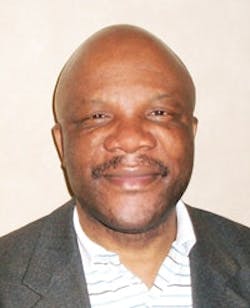Up Close & Personal
Each year, attendees of the American Water Works Assn. Annual Conference and Exposition (AWWA ACE) look forward to touring water and wastewater facilities in the show’s host city. WWD Managing Editor Elizabeth Lisican recently spoke with Nosa Irenumaagho, assistant manager of Dallas’ Southside Wastewater Treatment Plant, about one of this year’s featured tours.
Elizabeth Lisican: What is the Southside Wastewater Treatment Plant’s history? What population does it serve?
Nosa Irenumaagho: Southside Wastewater Treatment Plant is one of two wastewater plants owned and operated by the city of Dallas. The plant is responsible for treating wastewater generated by an estimated 1.25 million citizens of Dallas and 11 customer cities. In addition, solids treatment for both plants is consolidated at Southside.
Southside was initially constructed in 1964 to provide oxidation pond treatment for 3 million gal per day (mgd) of raw wastewater. Since then, the plant has undergone three expansions (and modernization) to reach its current capacity of 110 mgd, and peak flow of 190 mgd.
The completion of Phase III in 1988 increased the plant’s capacity to 90 mgd. This phase added four grit units, six modular trains of primary clarification, aeration and secondary clarification. This phase also added 12 effluent filters and two serpentine chlorine contact chambers. A new chlorine building was constructed to house bulk chlorine storage tanks and feed equipment while the original chlorine building was modified to house bulk sulfur dioxide storage tanks and associated feed equipment. In 1998, the plant capacity was rerated to 110 mgd, based on hydraulic modeling and without construction of additional treatment facilities.
Lisican: How does the plant handle specific treatment challenges?
Irenumaagho: Our strategy starts with identifying the challenge and its root cause through various discussions and meetings. These meetings could include outside engineers and consultants. Further discussion identifies possible solutions, ranks some select solutions and identifies implementation schedule, followed by construction and/or modification. In addition, Southside personnel continue training, [which] prepare[s] them to meet future challenges.
Lisican: What new technologies are being considered for the future?
Irenumaagho: On the immediate horizon—and already planned—is a biological nutrient removal process using enhanced biological phosphorus removal to meet an anticipated, more stringent permit limit. For safety and security reasons, ozone is recommended to be implemented as primary disinfection and micro constituent removal technology. The plant is continuing to enclose most facilities for odor control using environmentally friendly, in-ground biofiltration technology.
Lisican: What can visitors expect when they tour this plant during ACE12?
Irenumaagho: Upon arrival, visitors will discover the natural beauty of the Southside plant. Southside is unique compared to other large treatment plants in Texas and perhaps the nation. It is located on approximately 2,800 acres in the floodplain of the Trinity River. An extensive levee system protects the plant site and several thousand acres of adjoining private property from a 100-year flood.
The plant is surrounded by a 500-ft-wide buffer zone, which has been transformed into a multi-functional linear lake system. In addition to its park-like beauty, the linear lake provides storm water conveyance and storage for the adjacent neighborhoods and is a habitat for numerous wildlife, inhabited by a diverse population of local and migratory species. It is a popular spot for bird watching, picnicking and fishing. The plant is completely isolated from its neighboring environment. WWD
Download: Here
